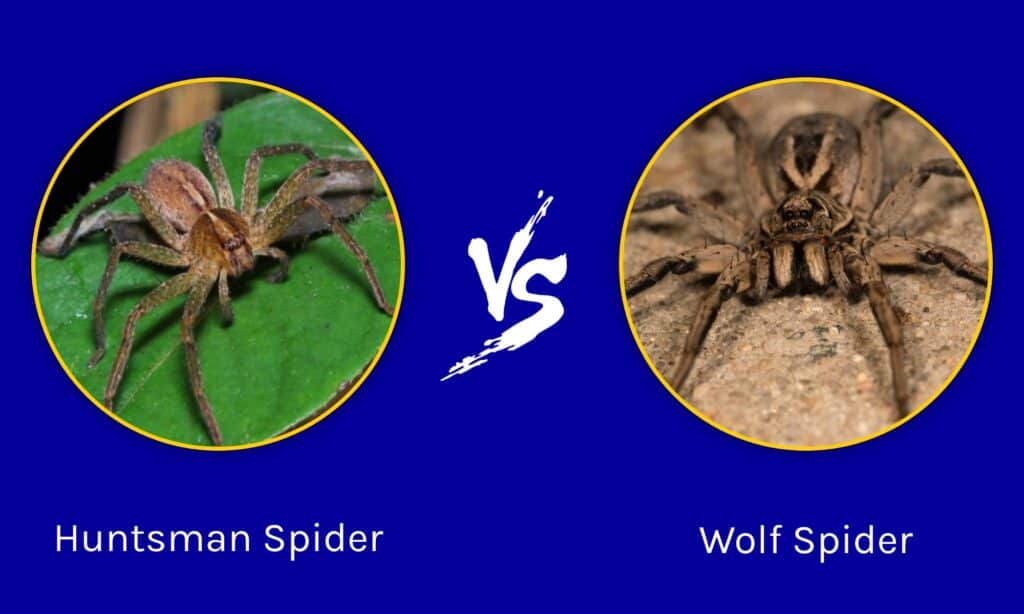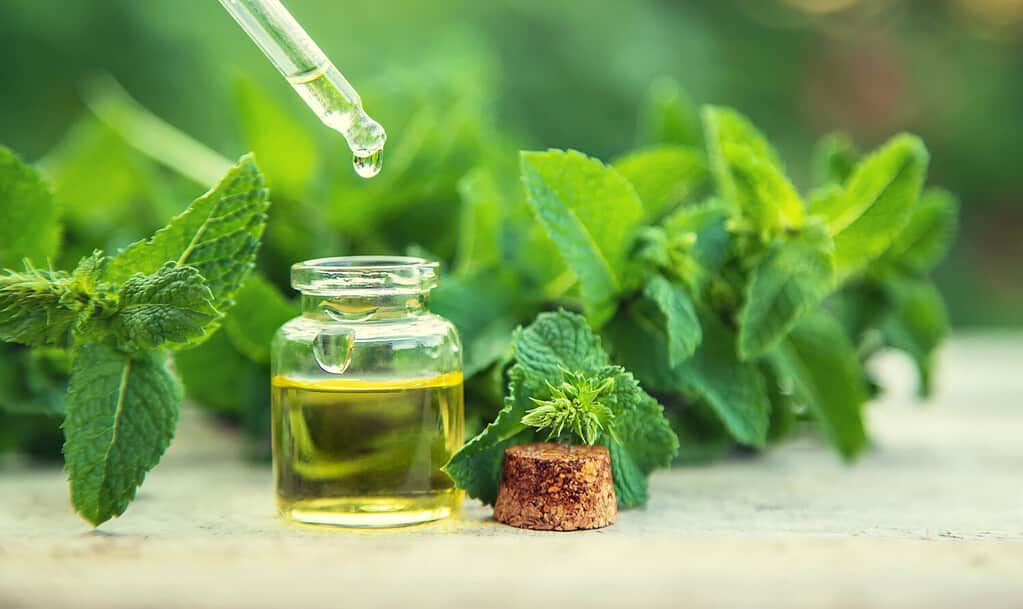It is said that the huntsman spider is the most eerie-looking of all the Australian spiders. It may be found all over Australia. It is also the largest spider species on the planet by leg span! It is frequently mistaken for other spiders, such as the wolf spider. Wolf spiders and huntsman spiders are both nocturnal scavengers that can run extremely quickly. Wolf spiders, unlike the huntsman, prefer to stay on the ground and can be found in and around your garden, especially in leafy waste. The differences between these two ominous-looking creatures deserve more examination. Let’s explore more!
Huntsman Spider vs Wolf Spider: A Comparison

| Huntsman Spider | Wolf Spider | |
|---|---|---|
| Size | Typically an inch long | Up to two inches long |
| Colors | Brown or gray | Black, orange, brown, gray |
| Features | Eight eyes in two rows. Spiny, crab-Like Legs | Eight eyes |
| Habitats | Mostly tropical or warm temperate regions | The United States and Inland / Coastal Settings |
| Mating Habits | Uses vibrations and sound patterns | Varies based on region Females sometimes eat males |
| Venomous | Yes, not deadly to people or pets | Yes, not deadly to people or pets |
Key Differences Between Huntsman Spiders and Wolf Spiders
The key differences between huntsman spiders and wolf spiders are their appearance, behavior, and habitat.
Members of the Sparassidae family, which includes the arachnids known as “huntsman spiders,” can be found in a variety of tropical and semi-tropical locations. Wolf spiders are members of the family Lycosidae. They got their moniker from their wolf-like behavior exhibited when hunting. Numerous countries, including the United States, have wolf spiders, with the biggest concentrations occurring in and around North Carolina. Let’s examine the contrasts in appearance, behavior, and habitats in more detail.
Appearance

Huntsman spiders have a leg span of up to 5 inches.
©Pong Wira/Shutterstock.com
Huntsman Spider vs Wolf Spider: Size
The leg span of a huntsman spider can be up to 5 inches, and the body itself is only approximately one inch long. However, huntsman spiders often grow well beyond this, with some, like the giant huntsman spider, reported to have a leg span of up to 12 inches! On the other hand, wolf spiders range in size from half an inch to over two inches and have a leg span of up to around 3 inches.
Huntsman Spider vs Wolf Spider: Colors
Wolf spiders don’t have the spectacular appearance of other spiders since they rely on camouflage for security. In general, they are found in colors orange, brown, gray, or black, depending on where they live.
The basic coloration of huntsman spiders’ upper surfaces is brown or gray, although many species have undersides that are patterned in black and white, with reddish patches around the mouthparts of the species. There are striped bands on the legs of the banded huntsman, which are big and gray to brown. The badge huntsman, another species, is a big, brown, and hairy creature.
Huntsman Spider vs Wolf Spider: Body Parts
The head of all wolf spiders has eight dark eyes arranged in a circle. At the top of the spider’s head are two enormous eyes; two additional large eyes look out the front, and four smaller eyes line up above the spider’s mouth. Wolf spiders have superb vision, unlike most other arachnids, which are blind or have weak vision. This is because the wolf spider’s secondary eyes have reflective tissues. As a result of this, the spider’s eyes “glow” when exposed to light. Only Salticidae jumping spiders and huntsman spiders can match the wolf spider’s superb eyesight. Wolf spiders are generally hairy and have a bear stripe running down their backs.
Huntsman spiders have eight eyes. The eyes appear in two largely forward-facing rows of four on the anterior aspect of the prosoma. The legs of huntsman spiders are twisted in such a way that they protrude forward in a crab-like fashion rather than being jointed vertically to the body. Their legs have spines, but their bodies are fuzzy. These spiders’ eyesight is inferior to the wolf spider, but their vision is still good enough to identify humans or other large creatures from afar.
Habitats and Habits

Texas wolf spiders are harmless to humans, but larger specimens can give a painful bite.
©Brett Hondow/Shutterstock.com
Huntsman Spider vs Wolf Spider: Habitat
Wolf spiders have a vast range. They are common throughout the United States, especially in California, Missouri, and Texas. Wolf spiders also inhabit a variety of coastal and inland settings. Wet coastal forests, alpine meadows, and suburban gardens are examples of dwellings they prefer. While certain species require specific microhabitats, most are vagrants. Some dig or open burrows with protective leaves and pebble closures. They are often found in man-made areas like barns and outdoor furniture.
Huntsman spiders are found in tropical and warm temperate areas globally. Some species, like the green huntsman spider, are native to cooler regions. The cane huntsman and the social huntsman, both tropical species, have been mistakenly introduced to many subtropical areas of the world, including New Zealand. The huntsman spiders found in southern Florida are also an invasive Asian species. Their speed allows them to hunt and consume cockroaches in many homes as well.
Huntsman Spider vs Wolf Spider: Mating Habits
Many wolf spider species have complicated courtship activities. Some wolf spider mating activities are universal, while others are species-specific. Some wolf spider species use visual cues as well as seismic signaling in their courtship displays, such as waving the front two legs in front of the female. Males who have mated will be more successful in their next attempt, whereas females who have mated are less successful. Oftentimes, female wolf spiders that have already mated will eat any male that tries to mate with them.
Researchers recently discovered that male huntsman spiders create a specific sound when they detect a female’s pheromone. Strong abdominal vibrations generate much of the sound. Females of their species will approach if they are interested in mating since they have a distinctive vibration frequency and sound pattern.
Huntsman Spider vs Wolf Spider: Venomous
The Sparassidae family of spiders use venom to paralyze their prey. In the past, they were known to bite humans, although rare. They are typically docile. Bites may induce swelling and discomfort along with other symptoms. Huntsman bites normally do not necessitate a trip to the hospital. When threatened, female huntsman spiders will defend their egg-sacs and young with ferocious bites and attacks.
If provoked repeatedly, wolf spiders will inject venom. Otherwise, they are not out to harm you. Swelling, slight discomfort, and itching are all symptoms of their bites. Some South American species were previously blamed for necrotic bites, but more recent research shows that these diseases were likely caused by bites from different genera.
Wrapping Up Huntsman Spider vs Wolf Spider

Wolf spiders are venomous to their prey, but a bite on a human is rare and usually only causes mild discomfort.
©iStock.com/Michele Jackson
There are significant distinctions between these two spiders that may be seen when they are compared side by side. Not only do their habitats differ, but so do their physical appearances and mating habits as well. One quick way to tell the difference is that the wolf spider has short legs for a spider, especially when compared to the huntsman spider, whose legs may grow up to 2 inches in length!
Bonus: What Keeps Spiders Away?

Spiders find certain essential oil scents repugnant like peppermint oil.
©Tatevosian Yana/Shutterstock.com
One of a person’s worst nightmares is having spiders wind up in their home–especially the venomous kind! The best way to avoid getting bitten by a spider is to try and prevent them from entering your house in the first place. As spiders can get into your home through holes and cracks, you can check for possible entryways with a flashlight. If the light gets through from the inside to the outside, you should fill that hole or crevice with an appropriate product.
Keeping your yard free of debris and overgrown vegetation helps cut down on areas spiders would gravitate to. Caulking doors and windows is also a good strategy to keep them out.
Spiders hate certain scents, so scented essential oils can help deter them like peppermint, tea-tree, lavender, and rose. You can add 15-20 drops of a particular oil in a water bottle mixed with water and spritz it around your house. They also hate the smell of cinnamon and vinegar, so these scents can be used similarly.
Regular cleaning inside your home, especially in areas that are dark or less frequented, is necessary to keep spiders from setting up residence. It’s also important to keep an eye on fruit bowls, as they can attract spiders.
The photo featured at the top of this post is © iSKYDANCER/Shutterstock.com
Thank you for reading! Have some feedback for us? Contact the AZ Animals editorial team.






